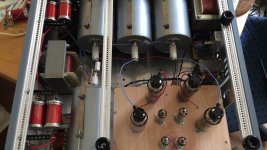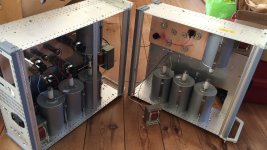The obvious question is how does the CORONA unit compare to Beryllium and Diamond tweeters, something that wasn't really around 2-3 decades ago when the CORONA was a thing. Anyone wana chime in ??
I am very curious myself if the plasma tweeter has something to offer that hard dome tweeters might now and vice versa
I am very curious myself if the plasma tweeter has something to offer that hard dome tweeters might now and vice versa
Hello,
I builded my own plasma tweeters because it was a simple low cost project and it abble to me to learn the tubes electronic.
I don't earded any berylium tweeter but they are my best tweeters of my speakers.
I builded my own plasma tweeters because it was a simple low cost project and it abble to me to learn the tubes electronic.
I don't earded any berylium tweeter but they are my best tweeters of my speakers.
I know both Be, Dia and plasma compete well in frequency response domain, what I am wondering about is how they compete in the distortion department. The issues is that the available info about this is slim to non. The only tweeter that got some attention here is the Acapella Ion tweeter which has issues. The CORONA tweeter apparently does much better.
I have vague recollections of people saying distortion characteristics weren't that good on plasma tweeters, but couldn't find what I was thinking of with a quick search.
Did find this though, which has some data:
https://www.pppl.gov/sites/pppl/files/basic_pages_files/Initial Plasma Loudspeaker Analysis.pdf
Did find this though, which has some data:
https://www.pppl.gov/sites/pppl/files/basic_pages_files/Initial Plasma Loudspeaker Analysis.pdf
This is true, lots of distortion but who cares? Second harmonics of 8khz is not audible (at my age haha)
I did find them for the Acapella Ion tweeter - see link bellow. I am going to compare does to the BlieSMa T25B-6 beryllium tweeter. For this, I am using Hifikompass's measurements and an online calculator for dB to THD. I will compare at 90dB followed by 100dB SPL. Selected frequencies (spot) is 2kHz, 5kHz and 10kHz with primary focus on 2nd and 3rd harmonics. Lower percentage is better.
90dB & 2nd - 2kHz - 5kHz - 10kHz
Acapella: 0.38% 0.8% 0.6% (notice that from 4kHz, the fundamental and 2nd harmonic is identical)
BlieSMa: 0.25% 0.18% 0.25%
90dB & 3rd - 2kHz - 5kHz - 10kHz
Acapella: 0.3% 0.08% /
Bliesma: 0.056% 0.004% 0.006%
100dB & 2nd - 2kHz - 5kHz - 10kHz
Acapella: 0.7% 2.5% 1.8%
BlieSMa: 0.56% 0.31% 0.56%
100dB & 3rd - 2kHz - 5kHz - 10kHz
Acapella: 0.9% 0.03% /
BlieSMa: 0.07% 0.003% 0.01%
The CORONA and Acapella is fairly similar in construction. I know Lansche upgraded their unit in 2008 which introduced the 8mm combustion chamber. How much better the CORONA unit is compared to Acapella is difficult to say since there is no data available, at least to my knowledge.
acapella ion TW 1S plasma tweeter measurment and impression
BlieSMa T25B-6 | HiFiCompass
Total Harmonic Distortion Calculator
90dB & 2nd - 2kHz - 5kHz - 10kHz
Acapella: 0.38% 0.8% 0.6% (notice that from 4kHz, the fundamental and 2nd harmonic is identical)
BlieSMa: 0.25% 0.18% 0.25%
90dB & 3rd - 2kHz - 5kHz - 10kHz
Acapella: 0.3% 0.08% /
Bliesma: 0.056% 0.004% 0.006%
100dB & 2nd - 2kHz - 5kHz - 10kHz
Acapella: 0.7% 2.5% 1.8%
BlieSMa: 0.56% 0.31% 0.56%
100dB & 3rd - 2kHz - 5kHz - 10kHz
Acapella: 0.9% 0.03% /
BlieSMa: 0.07% 0.003% 0.01%
The CORONA and Acapella is fairly similar in construction. I know Lansche upgraded their unit in 2008 which introduced the 8mm combustion chamber. How much better the CORONA unit is compared to Acapella is difficult to say since there is no data available, at least to my knowledge.
acapella ion TW 1S plasma tweeter measurment and impression
BlieSMa T25B-6 | HiFiCompass
Total Harmonic Distortion Calculator
Last edited:
Yes, numbers are better of a conventional loudspeaker but so are the numbers of amps with lots of feedback. Did you ever audit a plasma loudspeaker? If so, you know the "magic" they add to the sound.
No I have not, since a) they aren't exactly easy to come by and b) they are expensive. But I would certainly love to compare it against say the stellar T25B-6. That is the only way to really know.
This is true, lots of distortion but who cares? Second harmonics of 8khz is not audible (at my age haha)
Except that the non-linearities that produce harmonics also can produce intermodulation products that will fall into the audible range. For example, 17kHz minus 16kHz equals a very audible 1kHz.
The very strong “ultrasonic” resonances of stiff diaphragms such as Be and diamond can result in breakup due to non-linear bending modes, if driven hard enough by very high frequencies. This can then affect lower audible frequencies by intermodulation. I have often wondered if speakers such as these would benefit from a very high-Q notch filter at the resonant frequency, implemented either in the passive crossover or in an active filter.
Brian: If you investigate the T25B-6, you will see that the cone breakup is at 45kHz and it s nicely controlled, aka it is not critical. Any IMD due to the 45Khz will be so small you can't hear it <20kHz, yet alone <15kHz.
Brian: If you investigate the T25B-6, you will see that the cone breakup is at 45kHz and it s nicely controlled, aka it is not critical. Any IMD due to the 45Khz will be so small you can't hear it <20kHz, yet alone <15kHz.
The higher the resonance, the better, of course. There will be less chance of excitation by signals. Damping the resonance is probably good, but it does spread wider the bandwidth over which excitation can be problematic. Still, DSD/SACD noise, ultrasonic tip resonances in moving-coil cartridges, and good 15ips or 30 ips tape recordings can still be problematic to hard domes.
I hear a common “character” among most hard dome tweeters. The absence of these types of severe breakup modes in electrostatic and ribbon tweeters (which have their own problems) is why many of us prefer them.
Uneven hor vs vert dispersion is why I have a problem with foil/ribbon. This is kinda like: Pick your poison. That's why there are two dome materials or nothing: Beryllium and Diamond... with the option of using plasma, which I have not tested yet.
And yes, ultrasonic filter is not a bad idea.
And yes, ultrasonic filter is not a bad idea.
Uneven hor vs vert dispersion is why I have a problem with foil/ribbon.
Differing perspectives. A ribbon lends itself to being used in a tall line source. My Apogee tweeter ribbons are nearly 80” tall. No matter where you sit or stand, you can hear the highs. Big Magneplanars are similar. The point-source drivers are more problematic in a room, but that’s a bigger debate than we should have here.
I use full range ESL's without any audible breakup issues even at high SPL using direct drive servo amps.
Now we’re talking! 😃
- Home
- Loudspeakers
- Planars & Exotics
- plasma tweeter

